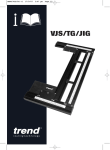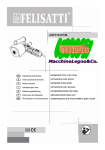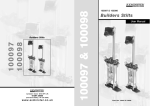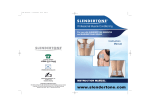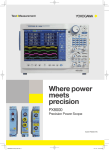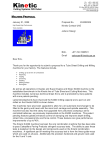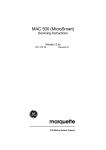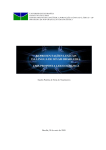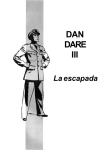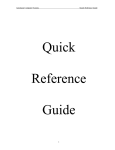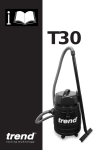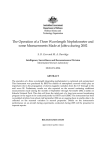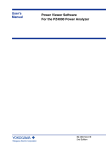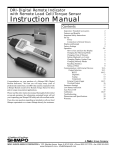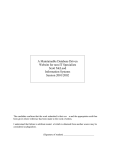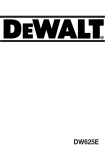Download User Manual Click to
Transcript
MANU-T10 v3.2 1/12/10 14:53 Page 30 T10 & T11 MANU-T10 v3.2 1/12/10 14:52 Page 1 T10 & T11 Dear Customer Thank you for purchasing this Trend product, we hope you enjoy many years of creative and productive use. Please remember to return your guarantee card within 28 days of purchase. TECHNICAL DATA Voltage: 230V 115V 230V Type 6 Power input 2000W Power output 11 00W No load speed (min.) 8,000-20,000 rpm Router carriage 2 columns Router carriage stroke 80mm Revolver depth stop 3-step, turret stop adjustment with graduation 1/2 inch (12.7mm) Collet size: UK & Eire Europe 12mm Cutter diameter, max. T10 50mm T11 70mm Weight 6.3kg Fuse: UK & Eire 230V 13A in plug UK & Eire 110V 32A in mains Europe 230V 10A in mains CONTENTS TECHNICAL DATA _____________________1 SAFETY ____________________________2-3 ELECTRICAL SAFETY _________________4 EC DECLARATION OF CONFORMITY ____5 ITEMS ENCLOSED ____________________5 DESCRIPTION OF PARTS _____________6-7 ASSEMBLY & ADJUSTMENT – Switching On & Off____________________8 – Depth of Cut _________________________8 – Fitting & Removing Cutters _____________9 – Speed Control ______________________10 – Fixing Points for Accessories ___________10 T10 – Dust Extraction Spout ________________11 – Fine Height Adjuster Accessory _________11 T10 & T11 – Template Guide Bush_________________12 T11 – Dust Extraction Spout ________________13 – Fine Height Adjuster__________________14 – Accessories ________________________15 OPERATION – Cutting Direction & Feed Speed ________16 – Side-fence Routing___________________17 – Template Guide Bush Routing __________18 – Beam Trammel Routing Accessory ______19 – Bearing Guided Cutters _______________20 – Freehand Routing & Batten Routing _____21 MAINTENANCE & CARE_______________22 ENVIRONMENTAL PROTECTION________22 GUARANTEE ________________________22 SPARE PARTS – Spare Parts List __________________23-26 – Spare Parts Diagram _________________27 UK & Eire UK & Eire Europe The following symbols are used throughout this manual: Denotes risk of personal injury, loss of life or damage to the tool in case of nonobservance of the instructions in this manual. Denotes risk of electric shock. For 115 Volt The 115V router is not supplied with a plug. We recommend a 32A BS4343 110V plug is used. Minimum generator or transformer requirement 3 kVA continuous with a 32A BS4343 110V socket outlet. The 115V router cannot be used with a 115V No-Volt Release Switch. INTENDED USE The router has been designed for professional heavy duty routing of wood, wood based products and plastics. The router is intended for routing grooves, edges, profiles and slots as well as copy routing. At reduced speed with the appropriate router cutter fitted nonferrous alloys can also be routed. These routers are professional power tools. DO NOT use under wet conditions or in presence of flammable liquids or gases. If you require further safety advice, technical information or spare parts, please call Trend Technical Support or visit www.trend-uk.com DO NOT let children come into contact with the tool. Supervision is required when inexperienced operators use his tool. -1- MANU-T10 v3.2 1/12/10 14:52 Page 2 T10 & T11 SAFETY WARNING: outdoors. Wear protective hair covering to contain long hair. awkward or uncomfortable hand positions. 17.Don’t abuse the cable. Never carry 5. Consider working environment. Do power tool or accessory by cord or not use the product in the rain or in a pull it to disconnect from the socket. damp environment. Keep work area Keep cord from heat, oil and sharp well lit. Do not use power tools near edges. Always trail the power cord gasoline or flammable liquids. Keep away from the work area. workshop at a comfortable temperature so your hands are not cold. Connect machines that are used 18.Connect dust extraction equipment. If devices are provided for the in the open via a residual current connection of dust extraction and device (RCD) with an actuation collection facilities, ensure these are current of 30 mA maximum. Use only connected and properly used. extension cables that are approved for outdoor use. 19.Check all fixing and fastening nuts, bolts and screws on power tool, PLEASE KEEP THESE 6. The accessory or attachment must be attachment and cutting tools before INSTRUCTIONS IN A SAFE PLACE. kept level and stable at all times. use to ensure they are tight and The attention of UK users is drawn to The 7. Keep work area clean. Cluttered secure. Periodically check when Provision and Use of Work Equipment machining over long periods. workshops and benches can cause Regulations 1998, and any subsequent injuries. Ensure there is sufficient 20.Stay alert. Watch what you are doing. amendments. room to work safely. Use common sense. Do not operate Users should also read the HSE/HSC tools when you are tired, under the 8. Secure idle tools. When not in use, Safe Use of Woodworking Machinery influence of drugs or alcohol. tools should be stored in a dry and Approved Code of Practice and Guidance high or locked up place, out of reach 21.Personal Protective Equipment (PPE) Document and any amendments. of children. for eye, ear and respiratory protection Users must be competent with must be worn. All PPE must meet 9. For best control and safety use both woodworking equipment before using our current UK and EU legislation. hands on the power tool and products. attachment. Keep both hands away 22.Do not leave tools running from cutting area. Always wait for the IMPORTANT NOTE: unattended. Do not leave tool until it spindle and cutter to stop rotating comes to a complete stop. Residual Risk. Although the safety before making any adjustments. instructions and operating manuals for 23.Always clamp workpiece being our tools contain extensive instructions on 10.Always keep guards in place and in machined securely. good working order. safe working with power tools, every 24.Only use cutting tools for power tool involves a certain residual risk 11.Remove any nails, staples and other woodworking that meet EN847-1/2 which cannot be completely excluded by metal parts from the workpiece. safety standards, and any safety mechanisms. Power tools must subsequent amendments. 12.Maintain tools and cutters with care. therefore always be operated with Keep cutters sharp and clean for caution! 25.Vibration levels. Hand held power better and safer performance. Do not tools produce different vibration General use damaged cutters. Follow levels. You should always refer to the 1. Disconnect power tool and attachment instructions for lubricating and specifications and relevant Health & from power supply when not in use, changing accessories. Keep handles Safety Guide. before servicing, when making dry, clean and free from oil and adjustments and when changing grease. Routing Safety accessories such as cutters. Ensure 1. Read and understand instructions 13.Maintain accessories. Do not use switch is in “off” position. Always supplied with power tool, attachment damaged accessories. Only use ensure cutter has stopped rotating. and cutter. accessories recommended by the 2. Always mount the power tool, manufacturer. 2. Keep hands, hair and clothing clear of accessory or attachment in conformity the cutter. 14.Check damaged parts. Before with the instructions. Only use operation inspect the attachment, the 3. Remove adjusting keys and attachment and accessories specified power tool, the cable, extension cable in the power tool manual. The tool or spanners. Check to see that keys and the plug carefully for signs of attachment should not be modified or and adjusting spanners are removed damage. Check for alignment of used for any application other than from the router tool, cutter and moving parts, binding, breakage, that for which it was designed. Do not attachment before turning router on. mounting and any other conditions force tool. Make sure cutter can rotate freely. that may effect its operation. Have any 3. Keep children and visitors away. Do 4. Noise. Take appropriate measures damage repaired by an Authorised not let children or visitors touch the for the protection of hearing if the Service Agent before using the tool or tool, accessory or attachment. Keep sound pressure of 85dB(A) is accessory. Protect tools from impact children and visitors away from work exceeded. Routing sound pressure and shock. area. Make the workshop child proof may exceed 85dB(A), so ear 15.Do not use tool if switch does not turn with padlock and master switch. protection must be worn. it on or off. Have defective switches 4. Dress properly. Do not wear loose 5. Eye protection. Always wear eye replaced by an Authorised Service clothing or jewellry, they can be protection in the form of safety Agent caught in moving parts. Rubber goggles, spectacles or visors to 16.Don't over reach. Keep proper footing gloves and non-skid footwear is protect the eyes. and balance at all times. Do not use recommended when working Observe the safety regulations in the instruction manual of the power tool to be used. Please read the following instructions carefully. Failure to do so could lead to serious injury. When using electric tools, basic safety precautions, including the following should always be followed to reduce the risk of fire, electric shock and personal injury. Also observe any applicable additional safety rules. Read the following safety instructions before attempting to operate this product. -2- MANU-T10 v3.2 1/12/10 14:52 Page 3 T10 & T11 6. Respiratory protection. Wear a face or dust mask, or powered respirator. Dust masks/filters should be changed regularly. indicated on the shank. This ensures that at least 3⁄4 of the shank length is held in the collet. Ensure clamping surfaces are cleaned to remove dirt, grease, oil and water. component being machined. Ensure any attachment is securely fitted to the workbench, with table surface at approximately hip height. 7. Do not switch router on with the cutter 6. Use a No-Volt Release Switch. Ensure touching the workpiece. At the end of 10.Observe the correct assembly and it is fixed securely, easily accessible fitting instructions in the router the cut, release the router plunge and and used correctly. instruction manual for fitting the collet, allow spindle to stop rotating. Never 7. In router table (inverted) mode, stand nut and cutter. use the spindle lock as a brake to the front right of the table. The 8. The direction of routing must always 11.Tool and tool bodies shall be clamped cutter will rotate anti-clockwise when in such a way that they will not be opposite to the cutter's direction of viewed from top so the feed direction become loose during operation. Care rotation. Do not back-cut or climb-cut. is from the right (against the rotation of shall be taken when mounting cutting the cutter). In overhead mode, stand 9. Check before cutting that there are no tools to ensure that the clamping is by to the front left of the machine table obstructions in the path of the router. the shank of the cutting tool and that and the feed direction is from the left. Ensure there are no obstacles the cutting edges are not in contact beneath workpiece when cutting full 8. Do not reach underneath table or put with each other or with the clamping thickness, and that a sacrificial work your hands or fingers at any time in elements. surface is used. the cutting path while tool is connected 12.It is advisable to periodically check the to a power supply. Router Cutter Safety collet and collet nut. A damaged, worn 9. Never thickness timber between the 1. Cutting tools are sharp. Care should or distorted collet and nut can cause back of the cutter and the backfence. be taken when handling them. Do not vibration and shank damage. Do not drop cutters or knock them against over-tighten the collet nut Useful Advice When Routing hard objects. Handle very small 1. Judge your feed rate by the sound of 13.Do not take deep cuts in one pass; diameter cutters with extra care. the motor. Feed the router at a take several shallow or light passes to Always return cutter to its packaging constant feed rate. Too slow a feed reduce the side load applied to the after use. rate will result in burning. cutter and router. Too deep a cut in 2. Always use cutters with a shank one pass can stall the router. 2. Trial cuts should be made on waste diameter corresponding to the size of material before starting any project. 15.In case of excessive vibrations whilst the collet installed in your tool. using the router stop immediately and 3. When using some attachments e.g. a 3. The maximum speed (n.max) marked have the eccentricity of the router, router table or dovetail jig, a fine on the tool, or in instructions or on router cutter and clamping system height adjuster is recommended. packaging shall not be exceeded. checked by competent personnel Where stated the speed range shall 4. When using a template guide bush, be adhered to. Recommended speeds 15.All fastening screws and nuts should ensure there is sufficient clearance be tightened using the appropriate are shown in the Trend Routing between cutter tip and inside edge of spanner or key and to the torque Catalogue and/or website. bush and that it cannot come into value provided by the manufacturer. contact with collet and nut. Ensure 4. Always use router cutters in a router. cutter and guide bush are concentric. Drill and boring bits must not be used 16. Extension of the spanner or tightening using hammer blows shall in a router. Router cutters must only Router Cutter Repair/Maintenance not be permitted. be used for the material cutting 1. Repair of tools is only allowed in application for which they are 17.Clamping screws shall be tightened accordance with the manufacturers designed. Do not use on metal or according to instructions provided by instructions. masonry. the manufacture. Where instructions 3. The design of composite (tipped) tools are not provided, clamping screws 5. Never use cutters with a diameter shall not be changed in process of shall be tightened in sequence from exceeding the maximum diameter repair. Composite tools shall be the centre outwards. indicated in the technical data of the repaired by a competent person i.e. a powertool or attachment used. Using Routers In A Fixed Position person of training and experience, who has knowledge of the design 6. Before each use check that the cutting 1. Attention should be made to the requirements and understands the tool is sharp and free from damage. HSE’s Safe Use of Vertical Spindle levels of safety to be achieved. Do not use the cutting tool if it is dull, Moulding Machines Information Sheet broken or cracked or if in any other No.18 and any revisions. 4. Repair shall therefore include, e.g. the damage is noticeable or suspected. use of spare parts which are in 2. After work, release the router plunge accordance with the specification of 7. Cutters should be kept clean. Resin to protect the cutter. the original parts provided by the build up should be removed at regular manufacturer. 3. Always use a push-stick or push-block intervals with Resin Cleaner®. The when making any cut less than use of a PTFE dry lubricant will 5. Tolerances which ensure correct 300mm in length or when feeding the reduce resin build up. Do not use clamping shall be maintained. last 300mm of the cut. PTFE spray on plastic parts. 6. Care shall be taken that regrinding of 4. The opening around the cutter should 8. When using stacked tooling (multithe cutting edge will not cause be reduced to a minimum using blade, block and groover etc.) on a weakening of the body and the suitably sized insert rings in the table spindle arbor, ensure that the cutting connection of the cutting edge to the and closing the back fence cheeks or edges are staggered to each other to body. fitting a false fence on the back fence. reduce the cutting impact. Version 7.1 06/2006 9. Cutter shanks should be inserted into 5. Whenever possible use a work holding device or jig to secure the collet all the way to the line -3- MANU-T10 v3.2 1/12/10 14:52 Page 4 T10 & T11 Never use a light socket. Never connect the live (L) or neutral (N) wires to the earth pin marked E or ELECTRICAL SAFETY Power Supply The electric motor has been designed for one voltage only. Always check that the power supply corresponds to the voltage on the rating plate. Machines marked for 230 volt can also be operated from a 220 volt supply. . Using an Extension Cable I If an extension cable is required, use an approved triple core extension cable suitable for the power input of this tool (see technical data). The T10 & T11 is double insulated in accordance with EN 60745; therefore no earth wire is required. I When using a cable reel, always unwind the cable completely. Mains Plug Replacement (UK & Ireland only) I Also refer to the table below. Always check the condition of the cable and plug before starting with your work. Conductor size (mm2) 0.75 1.00 1.50 2.50 4.00 Should your mains plug need replacing and you are competent to do this, proceed as instructed below. If you are in doubt, contact an authorised Trend repair agent or a qualified electrician. Cable rating (Amperes) 6 10 15 20 25 I Disconnect the plug from the supply. I Cut off the plug and dispose of it safely; a plug with bared copper conductors is dangerous if engaged in a live socket outlet. Voltage 115 I Only fit 13 Amperes BS 1363A approved plugs fitted with a 13 Amp A.S.T.A approved BS 1362 fuse (1). I The cable wire colours, or a letter, will be marked at the connection points of most good quality plugs. Attach the wires to their respective points in the plug (see below). Brown is for Live (L) (2) and Blue is for Neutral (N) (3). 230 I Before replacing the top cover of the mains plug ensure that the cable restraint (4) is holding the outer sheath of the cable firmly and that the two leads are correctly fixed at the terminal screws. Cable length (m) 7.5 15 25 30 45 60 Amperes Cable rating (Amperes 0 - 2.0 6 6 6 6 6 10 2.1 - 3.4 6 6 6 6 15 15 3.5 - 5.0 6 6 10 15 20 20 5.1 - 7.0 10 10 15 20 20 25 7.1 - 12.0 15 15 20 25 25 12.1 - 20.0 20 20 25 - 0 - 2.0 2.1 - 3.4 3.5 - 5.0 5.1 - 7.0 7.1 - 12.0 12.1 - 20.0 6 6 6 10 15 20 6 6 6 10 15 20 6 6 6 10 15 20 6 6 6 10 15 20 6 6 10 15 20 25 6 6 15 15 20 - For 115V units with a power rating exceeding 1500W we recommend to use a plug to BS4343 standard. For T10 & T11 this must be rated to 32A. 13 AMP 1 2 3 WARNING: 115V units have to be operated via a fail-safe isolating transformer with an earth screen between the primary and secondary winding. 4 -4- MANU-T10 v3.2 1/12/10 14:52 Page 5 T10 & T11 increase the exposure level over the total working period. EC DECLARATION OF CONFORMITY T10E & T11E Trend declare that these products mentioned above are in compliance with 2006/42/EC, EN 60745-1, EN 60745-2-17. These products also comply with Directive 2004/108/EC. Managing Director Jeff Willcocks An estimation of the level of exposure to vibration should also take into account the times when the tool is switched off or when it is running but not actually doing the job. This may significantly reduce the exposure level over the total working period. Identify additional safety measures to protect the operator from the effects of vibration such as: maintain the tool and the accessories, keep hands warm, organisation of work patterns. MARKINGS ON TOOL The following pictograms are shown on the tool: Trend Machinery & Cutting Tools Ltd Unit 6 Odhams Trading Estate St Albans Road, Watford Herts, WD24 7TR United Kingdom Read instruction manual before use. Date Code Position The date code, which also includes the year of manufacture, is printed into the housing. Level of sound pressure according to 2006/42/EC, measured according to EN 60745: Example 2010 XX XX Year of Manufacture INFORMATION ON NOISE/VIBRATION T10 & T11 Wear ear protection! Vibration total values (triax vector sum) determined according to EN 60745: Vibration emission value ah Uncertainty K = m/s2 m/s2 4 ITEMS ENCLOSED The noise level when working can exceed 85 dB(A). ah = xxxx xx xx Lpa (sound pressure) 92 dB(A)1 Lwa (acoustic power) 100 dB(A)2 KPA (sound pressure uncertainty) 3 dB(A) KWA(sound power uncertainty) 3.4 dB 3.1 1.5 The vibration emission level given in this information sheet has been measured in accordance with EN 60745 and may be used to compare one tool with another. It may be used for a preliminary assessment of exposure. WARNING: The declared vibration emission level represents the main application of the tool. However if the tool is used for different applications, with different accessories or poorly maintained, the vibration emission may differ. This may significantly -5- 1 1 1 1 1 1 1 1 1 1 1 x x x x x x x x x x x Parallel side-fence with micro adjuster Fence rods (pair) Collet 1/2” (12.7mm) UK & Eire (Europe 12mm) Spanner (22mm A/F) Guide bush 30mm and fixing screws Inner plate and fixing screws Line-up pin 12mm/1/2” Dust extractor spout with fixing screws Dust extractor spout clip Instruction manual Guarantee registration card T11 only 1 x Fine height adjuster handle MANU-T10 v3.2 1/12/10 14:52 Page 6 T10 & T11 DESCRIPTION OF PARTS T10 A B C D E F G H I J K L M N O P Q R S T U V W X Y Z AA AB AC AD AE AF AG AH Plunge locking lever Variable speed control dial Handle Switch Depth stop locking knob Depth stop micro adjuster Depth stop height adjuster dial Depth stop scale Depth stop lens Thumb knob with anti-vibration spring for side fence Collet nut Spindle lock Base 3-way turret stop Collet Knurled nut Threaded spindle Threaded spindle cap nut Template guide bush dia. 30mm Template guide fixing screw Fence rods dia. 10mm x 360mm Parallel side fence Parallel side fence micro adjuster knob Spanner (22mm A/F) Dust spout 35mm dia. Dust spout fixing screws Dust spout fixing nut Dust spout insert Dust spout top clip Dust spout top clip screw Dust Spout underside clip Template guide bush line-up pin Inner plate fixing screws Inner plate B I G R 4 D H A C P E Q K F J X L N M AD O AC AF AH AB AA AG Y S AE T Z U W V -6- MANU-T10 v3.2 1/12/10 14:52 Page 7 T10 & T11 DESCRIPTION OF PARTS T11 A B C D E F G H I J K L M N O P Q R S T U V W X Y Z AA AB AC AD AE AF AG AH AI AJ AK AL Plunge locking lever Variable speed control dial Handle Switch AJ Depth stop locking knob Depth stop micro adjuster AL Depth stop height adjuster dial R Depth stop scale D Depth stop lens Thumb knob with anti-vibration spring for side fence Collet nut C Spindle lock Base P 3-way turret stop Q Collet Knurled nut Threaded spindle K Threaded spindle hex cap nut J Template guide bush dia. 30mm Template guide fixing screw Fence rods dia. 10mm x 360mm Parallel side fence Parallel side fence micro adjuster knob Spanner (22mm A/F) Dust spout 35mm dia. Dust spout fixing screws Dust spout fixing nut Dust spout insert Dust spout top clip Dust spout top clip screw Dust spout underside clip Quick release jig & table aperture Clamp guide system fitting Inner plate Inner plate fixing screw Fine height adjuster handle Template guide bush line-up pin Fine height adjuster handle dial B I G 4 H A E F AF X L M AG AD N AK AC O AH AB AI AA Y S AE T U Z W V -7- MANU-T10 v3.2 1/12/10 14:52 Page 8 T10 & T11 ASSEMBLY & ADJUSTMENT I Read the depth of cut using the measuring lens (5) and scale. Switching On & Off I Adjust the depth of cut to the millimetre using the knob (6). I On; pull the switch up. I Off; press the switch down. 5 6 ON I ON 4 I OFF O OF F O 4 Adjusting the Depth of Cut 2 I Place the machine with cutter fitted on to the workpiece. I Pre-set the 3-way turret stop (1) as required. I Undo the thumb knob (2) for securing the depth stop (3). 3 I Lift up the plunge locking lever (4) for fixing the depth. 1 I Lower the machine slowly until the cutter touches the workpiece and secure it with the locking lever. I Rotate the knob (6) until the depth stop micro adjuster (3) touches the revolving depth stop (1). I Set the measuring lens (5) to a round figure or zero. I Adjust the depth of cut using the knob (6) and the measuring lens (5). The distance between the top of the revolving depth stop and the bottom of the depth stop is the required depth of cut. I Tighten the knob (2). I Never make adjustments when the router is running or plugged in. The rotating turret stop screws can be used for pre-setting up to three depths of cut. Their height can be adjusted using a screwdriver (7) and an 8mm A/F spanner (8). I Deep cuts should always be routed in several passes. I When in plunging mode never release the plunge lever without the base of the router supported on a flat surface as this may damage the router housing or could cause injury. By turning the turret stop, three depth settings can be quickly made. 7 3 8 If the depth of cut needs re-adjustment, it is recommended to use the depth stop micro adjuster. I Adjust the depth of cut using the depth stop micro adjuster (3). One turn corresponds to approximately 1mm. 1 -8- MANU-T10 v3.2 1/12/10 14:52 Page 9 T10 & T11 How to Fit and Remove a Router Cutter 4 Fitting Cutters I Insert at least 3/4 of the shank length of the cutter (1) into the collet. I Press the spindle lock (2) forward until the router spindle is locked (you may need to turn the spindle slightly to engage it). I Tighten the collet nut with a spanner (3). Do not use excessive force. Removing Cutters I Undo the 22mm A/F collet nut with the spanner. 2 3 I Keep turning the spanner until the collet nut tightens and then loosens again. This is the fail-safe mechanism releasing the collet. I The cutter should now slide out. I Each time you finish using a cutter, remove it and store it in a safe place. 1 Correct Sequence for Fitting Collet, Nut and Cutter I Do not tighten the collet without a cutter fitted. I Always use cutters with shanks which match the diameter of the collet. (1) I Do not use cutters larger than 45mm unless the router is fitted in a router table. (2) CLICK I Care should be taken when removing cutter to avoid cuts to fingers. (3) -9- MANU-T10 v3.2 1/12/10 14:52 Page 10 T10 & T11 Setting the Electronic Speed Control Dial The speed is infinitely variable from 8,000 to 20,000 rpm using the electronic speed control dial (1) for uniform cutting results in all types of wood, plastics and in aluminium. 1 I Turn the electronic speed control dial to the required level. The dial is numbered from 1 to 5 and corresponds to router speeds from 8,000 rpm to 20,000 rpm. 5 I Generally, use the lower settings for large diameter cutters and the higher settings for small diameter cutters. The correct setting will also depend on the density of the material, depth of cut and feed speed of the router, as severe loss of rpm denotes motor overload. Dial No. 1 2 3 4 5 A whole range of accessories are shown in the Trend Routing Catalogue. 8,000 12,000 16,000 18,000 20,000 rpm rpm rpm rpm rpm 115mm Fixing Points for Accessories The router has three threaded holes M6 in its base that allow fitting of accessories and also fitting to router tables. Router Speed M6 15mm 75mm Using a Fine Height Adjuster The T10 has an optional fine height adjuster accessory Ref. FHA/003 and the T11 has a built in fine height adjuster called the Quick Raiser. These should be used when fine height adjustment of the cutter is required. This is especially recommended when using dovetail jigs or router tables. -10- MANU-T10 v3.2 1/12/10 14:52 Page 11 T10 T10 Fitting and Removing T10 Dust Extractor Spout 6 5 The dust extraction spout consists of a main section (1) with underside clip (7), an insert cover (2), top clip (5) with screw (6), two main screws (3) & two nuts (4). I Check underside clip (7) is fitted into main section. Slide the insert cover (2) onto the main section if required (1) and click into place. 35mm I Fit nuts (4) into main body. Place spout into base of router and secure with two screws (3). I Connect a dust extractor hose to the dust extraction spout (1). 2 I The top clip (5) can be used with hoses that have a removable adapter fitted. Loosen the screw in the top of the router and fit the top clip (5) as shown using screw (6). 4 1 3 7 Whenever possible use the dust extraction spout with a suitable extractor when routing. 1 Top clip (5) cannot be used with vacuum extractor hoses with a permanent adapter fitted. 2 Fitting the T10 Fine Height Adjuster Optional Accessory Ref. FHA/003 4 6 I Plunge router and lock lever (6) down. 5 I Remove hex cap (5) nut from threaded stud (3), using a 19mm A/F spanner. 4 I Remove knurled ring nut (4) from threaded stud (3). 3 I Place washer (2) on threaded stud. I Thread on main adjuster rod (1) for at least 25mm of thread. -11- MANU-T10 v3.2 1/12/10 14:52 Page 12 T11 T10 & T11 Fitting Template Guide Bush and Inner Plate 7 The routers have a unique built-in line up system for the template guide bush. This system ensures that the guide bush is exactly concentric to the router cutter to ensure accurate work. 3 6 I Turn the router upside down. I Fit inner plate (2) into the recess in the router base plate (1). For T10 the bushes on the inner plate must be towards the router motor. For T11 the raised side of the inner plate must be away from router base. Loosely fit the two pan head machine screws (3) through the inner plate and into the tapped holes. DO NOT TIGHTEN SCREWS. I Fit the 30mm template guide bush (6) to the inner plate (2). Fit guide bush with the two M5 countersink machine screws (7). Tighten these screws. I The line up pin (5) is stepped for 12mm and 1/2” collet (4) sizes. (For the 1/2” collet simply push the line up pin further down into the 1/2” collet). I Fit line up pin (5) into the 1/2” collet (8) (or 12mm depending on the size fitted) in the router, lightly tighten collet nut to hold the line up pin (5). I Release plunge lever and gently depress base until line up pin (5) projects through the 30mm guide bush (6). I Once in line, tighten the pan head machine screws (3) with a flat screwdriver. -12- 5 2 1 4 MANU-T10 v3.2 1/12/10 14:52 Page 13 T11 T11 Fitting Dust Extractor Spout Fitting and Removing T11 Dust Extractor Spout The dust extraction spout consists of a main section (1) with underside clip (7), an insert cover (2) and top clip (5) with screw (6). 6 5 A I Check underside clip (7) is fitted into main section. Slide the insert cover (2) onto the main section if required (1) and click into place. 35mm B I Clip into the base by pushing down the dust extraction spout (1) until clips engage in the recess. Removing Dust Extractor Spout I Connect a dust extractor hose to the dust extraction spout (1). I The top clip (5) can be used with hoses that have a removable adapter fitted. Loosen the screw in the top of the router and fit the top clip (5) as shown using screw (6). 4 2 C 1 B 3 I To remove dust extraction spout, push spout (1) to side and pivot out. A 7 For more permanent fixing, fit nuts (4) into main body, place spout into base of router and secure with two screws (3). Whenever possible use the dust extraction spout with a suitable extractor when routing. Top clip (5) cannot be used with vacuum extractor hoses with a permanent adapter fitted. 2 Using the T11 Without Fine Height Adjuster In portable use the knurled nut (2) should be wound to the top of the stud and hand tighten against the hex cap. The base of the knurled nut (4) should be aligned with the forks (3) in the router casting. 4 4 3 In normal plunge mode, ensure the base of the knurled nut is aligned correctly with the forks of the lower motor housing. This will enable the cutter to retract into the base safely. -13- MANU-T10 v3.2 1/12/10 14:52 Page 14 T11 Fitting the T11 Fine Height Adjuster The fine height adjuster (Quick Raiser) for the T11 can be used portably or when the router is held inverted in a table. If a suitable size access hole is drilled into the router table top, the height adjustment can also be adjusted from above the table top. Portable Use 5 To set up for fine height adjustment: 7 I Plunge router and lock lever down (1). 6 I Rotate the knurled nut (2) down the stud until it is close to the router casting forks (3). 4 1 I Align the base of the knurled nut (4) so that it will locate in the forks (3). I Release plunge locking lever (1). 2 Do not use a powered drill to drive the T11 Quick Raiser assembly. Only use the supplied handle. Ensure that the plunge locking lever is unlocked. Never use unnecessary force to rotate the Quick Raiser mechanism. Do not undo Torx® screw on hex nuts. 3 4 Inverted Use For Portable Use I Place the fine height adjuster handle (5) onto the top threaded spindle hex nut (6). 0.1 0.5 I Rotate handle clockwise to raise motor body and reduce cutter depth. 0 I Rotate handle anti-clockwise to lower motor body and increase cutter depth. 1.5 5 7 For Router Table Use I Ensure router is fitted into the router table (10), see opposite page. I Place fine height adjuster handle (5) through router table cutter hole onto bottom threaded spindle hex nut (9). 68mm I Rotate handle clockwise to raise motor body and raise cutter height. 9 I Rotate handle anti-clockwise to lower motor body and lower cutter height. One revolution corresponds to 1.5mm. The height adjuster handle dial (7) can be reset to zero. 36mm 10 -14- MANU-T10 v3.2 1/12/10 14:52 Page 15 T11 Modification of User Router Table for T11 Fine Height Adjuster To use fine height adjuster in table mode a 20mm diameter hole is required to be drilled into the router table top. To position the hole it is advisable to remove the phenolic base slider of the T11 router and use it as a template. I Mark the hole for the handle height adjuster in the table top using the phenolic base slider as a template. I Remove the phenolic base slider. I Mark with a punch the centre of the hole. I Drill a pilot hole in the centre. I Enlarge the hole to 20mm. I Remove any burrs. 2 A template is provided on page 28. Table Use Top View T11 Quick Release Fixing Kit Optional Accessory Ref. T11/JT/KIT The T11 Quick Release Fixing Kit uses three cams (1) to lock the router into a router table. The kit can be retro-fitted to user-made tables by drilling suitable size holes in a set pattern into the table surface. The kit comprises three cams, three bosses, three springs and three nut & bolt assemblies. The kit is supplied with instructions for drilling and using the cams. The cams locate into the three apertures (2) in the base of the T11 router. When using large panel raiser cutters, making deeps or if the router is to be used inverted for long periods, the router should also be secured using three M6 machine screws into the TBC router fixing holes. 3 T11 Clamp Guide System Optional Accessory Ref. T11/CGS/KIT The T11 has two M6 tapped holes in the upper face of the router base (3), which will accept the Clamp Guide System accessory (4). The accessory is used with the Clamp Guide System clamps (5) and is used to create parallel grooves and trenches. -15- 4 5 MANU-T10 v3.2 1/12/10 14:52 Page 16 T10 & T11 Feed Speed OPERATION Proper Hand Position To reduce the risk of serious personal injury, Always use proper hand position as shown To reduce risk of serious personal injury, Always hold securely in anticipation of a sudden reaction. The speed at which the cutter is fed into the wood must not be too fast that the motor slows down, or too slow that the cutter leaves burn marks on the face of the wood. Practice judging the speed by listening to the sound of the motor when routing Sequence of plunging Proper hand grip requIres one hand on each grip as shown. Step One Plunge down and lock the motor carriage, by depressing the plunge locking lever. Step Two Carry out the routing operation. Cutting Direction The direction of routing must always be opposite to the cutter’s direction of rotation. Otherwise there is a risk of kick-back. Step Three Release the plunge locking lever and the motor carriage returns to the normal position. Feed direction of router When routing always lock the plunge locking lever. Direction of cutter rotation Moulding Natural Timbers Feed Direction When edge moulding natural timbers, always mould the end grain first, followed by the long grain. This ensures that if there is ‘breakout’, this will be removed when the long grain is routed. 2 1 When routing along an edge, the direction of the router travel should be against that of the rotation of the cutter. This will create the correct cutting action and prevent the cutter ‘snatching’. It will also pull the router towards the workpiece and hence the side-fence or guide bearing will be less likely to wander from the edge of the workpiece. 3 4 -16- MANU-T10 v3.2 1/12/10 14:52 Page 17 T10 & T11 Side-Fence Routing B The side-fence is used to guide the router when moulding, edge profiling or rebating the edge of the workpiece or when routing grooves and slots in the centre of the workpiece, parallel to the edge. 7 The edge of the workpiece must be straight and true. The cheeks are adjustable and should be set ideally with a 3–4mm gap each side of the cutter. 9 3 2 A 4 8 1 6 I Feed along the timber, keeping sideways pressure (A) to ensure the side fence does not wander away from the workpiece edge and downward pressure on the inside hand (B) to prevent the router from tipping. Fitting and Using the Side Fence I Make sure the thumb knobs (3) are fully released. Slide the guide rods (1) into the routing base (2) and tighten the thumb knobs (3). I When finished, raise the router, secure with the plunge locking lever (9) and switch off. I Adjust the side-fence (4) to the required distance and clamp in place with the thumb knobs (3). I Then lower the cutter height until the cutter is just above the workpiece. I Fine adjustments are possible by slackening the underside locking knob (8), adjusting the micro-adjustment knob (6) and securing it again with the knob (8). One revolution of the micro-adjustment knob (6) equals 1.0mm of side-feed. When starting the cut, keep the pressure on the front cheek (C) until the back cheek contacts the workpiece edge. C I Lower the cutter onto the workpiece and set the cutter height by raising the depth stop (7) the required distance. I Switch on the router and when the cutter reaches full speed, gently lower the cutter into the workpiece and lock the plunge. -17- At the end of the cut, keep pressure on the back cheek (D) until the cut is finished. This will prevent the router cutter swinging in at the end of the workpiece and ‘nipping’ the corner. D MANU-T10 v3.2 1/12/10 14:52 Page 18 T10 & T11 Routing with a Template The guide bush is used in conjunction with a template when the routing operation is repetitive or the workpiece is complex in shape. The template is fixed to the upper surface of the workpiece. A cutter is chosen with a diameter which will pass through the centre of the bush leaving enough clearance. The cutter can be straight or shaped. The router can then be guided around the template so that the shape of the template will be replicated. Making the Template The template is cut from 6mm or 1/4” MDF, plywood or plastic to the shape required. The guide bush offset needs to be allowed for when calculating the shape of the template. The template must be smaller by an amount equal to the difference between the ‘outer edge of the guide ring’ and the ‘outer edge of the cutter’. See below for the offset calculation. The edge of the template must be free of imperfections as these will be replicated in the final workpiece. Using a template to rout a straight edge Calculations for template offset Alternatively it can be used for cutting shapes or making panelling grooves. Template Template guide bush Workpiece Template Guide bush fitted to router E d D Guide bush ring Cutter FORMULA (D-d) E= 2 -18- MANU-T10 v3.2 1/12/10 14:52 Page 19 T10 & T11 Beam Trammel Routing Optional Accessory Ref. BEAM/002 2 Cutting Arcs with the Router I Fit the beam trammel (1) to the router base (3). 5 I Place the machine on the workpiece and ensure pin on beam trammel will pierce the workpiece surface. I Measure the radius and fix the point of the beam trammel in position. I Fasten the beam trammel (1) in the routing base (3) with the thumb knob (4). I Set the cutting depth using the depth stop dial (2). I Switch on the machine. I After releasing the plunge locking lever (5), lower the machine slowly as far as the depth stop and lock it there. I Cut grooves, rebates etc. at a steady rate of feed, in an anti-clockwise direction. I When finished, release plunge locking lever (5) to raise the machine. 1 I Switch off the machine. Ensure the beam trammel point does not move, and that the cable will not foul. -19- 4 3 MANU-T10 v3.2 1/12/10 14:52 Page 20 T10 & T11 Bearing Guided Cutter Routing 1 Edge profiling and shaping cutters are available with a bearing fitted to the end. This enables shaped or straight workpieces to be routed without the need for a guiding device such as a side-fence or batten. The edge must be free from imperfections as these will be reflected in the finish of the mould. Often alternative diameters of bearings are offered which will change the shape of the resulting mould. With certain shapes such as the chamfer cutter below, increasing the depth of cut will produce a larger chamfered edge. I Fit the bearing guided cutter into the router collet. The guide bearing ensures the cutter follows the workpiece. I Place router onto the workpiece. I Set height of cutter using the depth stop (1). I Switch on the machine. I After releasing the plunge locking lever, lower the machine slowly as far as the depth stop. I With bearing of cutter running along board edge, mould the edge of the workpiece by moving the router in the direction shown. I A continuous motion should be used to prevent burning of the workpiece. When possible, take a number of passes at increased cutter depths. A light final pass will produce a good finish. Where the material thickness leaves insufficient room for the bearing to make contact, a second piece of material can be temporarily fixed beneath it for the ball bearing to follow. I When complete, retract the carriage by releasing the plunge locking lever. I Switch off the router. Keep downward pressure with the inside hand to prevent the router from tipping. -20- MANU-T10 v3.2 1/12/10 14:52 Page 21 T10 & T11 Freehand Routing with the Router The router can also be used for signwriting or creative freehand work without any form of guide. With practice, numbers or name plate designs can be routed freehand. Draw the design or motif on the workpiece and then rout the design, taking shallow passes. A v-groove cutter is ideal for engraving designs at shallow depths. Clamp Guide and Batten Routing Where a side fence cannot be used, it is also possible to guide the router along a Clamp Guide or batten clamped across the workpiece. The Clamp Guides have built in clamping. Use the straight edge of the router base and calculate the distance required from the edge of the Clamp Guide to the cut required. Standard technique is used, and side pressure applied to ensure the router does not wander from the Clamp Guide. Optional Accessories Since accessories, other than those offered by Trend, have not been tested with this product, use of such accessories with this tool could be hazardous. To reduce the risk of injury only Trend, recommended accessories should be used with this product. -21- MANU-T10 v3.2 1/12/10 14:52 Page 22 T10 & T11 MAINTENANCE AND CARE Lubrication Cleaning I The bearings of the machine need no lubrication, as they are sealed. The two plunge columns on the routing base should be slightly oiled from time to time. I Keep the machine clean at all times. Some maintenance products and solvents may damage the plastic parts, these include products containing Benzene, Trichloroethyle Chloride and Ammonia. I Keep the cooling vents on the motor housing clean and unobstructed at all times. Blow out any dust and dirt at regular intervals. I Never use any caustic agents to clean the plastic parts. I Visually check the carbon brushes. In the event of excessive sparking, they may need changing. Changing Brushes I After about 40 operating hours inspection by a authorised Trend Service Agent is recommended. Ensure machine is isolated from power supply. ENVIRONMENTAL PROTECTION The carbon brushes will need replacing when they become worn to a certain limit. TR EC EL O N Recycle raw materials instead of disposing as waste. Accessories and packaging should be sorted for environmental-friendly recycling. Separate collection. This product must not be disposed of with normal household waste. Household User IC Local regulations may provide for separate collection of electrical products from the household, at municipal waste sites or by retailer when you purchase a new product. It is advisable to have the brushes replaced by an authorised Trend Service Agent. The router will also be given a thorough inspection. Please call Trend Technical Support for advice as to how to dispose of unwanted Trend electrical product in an environmentally safe way or visit www.trend-uk.com I Undo the two screws and take off the top cover. Then undo the two screws and move variable speed control out of the way. Business User I Undo the screws holding the brush holder clamp and remove holder with brush. Please call Trend Customer services for disposal of unwanted Trend electrical products. I Remove leads, pull on brush tab and remove brush and fit new brush into holder. Then refit lead and replace brush assembly into the housing. GUARANTEE I Refit brush holder cover and screws. I Refit speed control to position and secure with screws and replace cover and secure with screws. This unit carries a manufacturers guarantee in accordance with the conditions on the enclosed guarantee card. For the location of your nearest Trend Service Agent, please call Trend Customer Services or see Stockist Locator at www.trend-uk.com I Always use original T10/T11 spare parts. -22- MANU-T10 v3.2 1/12/10 14:52 Page 23 T10 & T11 T10 & T11- SPARE PARTS LIST No. Qty. 1 1 1 1 1 1 1 1 1 1 2 2 2 2 1 1 1 2 2 1 1 2 2 1 1 1 1 2 4 1 1 2 1 1 4 4 2 1 1 1 1 1 4 1 2 2 3 4 5 6 7 8 9 10 11 12 13 14 15 16 17 18 19 20 21 22 23 24 26 27 28 29 30 31 v4.0 10/2010 Desc. Ref. } Armature 115V T10EL & T11EL c/w Fan <10/09 Armature 230V T10E & T11E c/w Fan <10/09 Armature 115V T10EL & T11EL c/w Fan >10/09 Armature 240V T10E & T11E c/w Fan >10/09 Field Coil 115V T10EL & T11EL <10/09 Field Coil 230V T10E & T11E <10/09 Field Coil 115V T10EL & T11EL >10/09 Field Coil 230V T10E & T11E >10/09 Switch Carbon Brush 115V (1 pair) <10/09 Carbon Brush 240V (1 pair) <10/09 Carbon Brush 115V (1 pair) T10EL & T11EL >10/09 Carbon Brush 240V (1 pair) T10E & T11E >10/09 2 Core Cable Only 115V UK T10L & T11L 2 Core Cable with Plug 230V UK T10 & T11 2 Core Cable with Plug 230V Euro T10&T11/EURO Brush Holder <10/09 Brush Holder >10/09 Top Vent Housing Field Housing Lead Field to Brush 115V (Yellow x 95mm) Lead Field to Brush 230V (Yellow x 175mm) Lead Speed Control (Red x 100mm F90-M) Switch Lever Machine Screw Csk M4 x 6mm Phillips Switch Slider Brush Holder Clamp Screw Self Tapping Pan 3.8mm x 12mm Phillips Top Bearing 12mm x 32mm x 10mm 6201-2RSL Circlip Screw Self Tapping Dome 4mm x 25mm Phillips Cable Guard 115V T10L & T11L Cable Guard 240V T10 & T11 Bolt Pan M5 x 68mm Phillips Washer Split M5 Screw Self Tapping Pan 3.2mm x 13mm Phillips Cable Clamp Lead Switch to Field (Red x 95mm F-M) Depth Stop Support (Left Hand) Depth Stop Support (Right Hand) Depth Stop Lens Screw Self Tapping Dome 3.8mm x 14mm PH Half Nut Hex M12 Screw Self Tapping Dome 4.8mm x 63mm PH } -23- See No. 114 WP-T10EL/001A WP-T10E/001A See No. 114 WP-T10EL/002A WP-T10E/002A WP-T10E/003 WP-T10EL/004 WP-T10E/004 WP-T10EL/004A WP-T10E/004A WP-T10L/005 WP-T10/005 WP-T10EUR/005 WP-T10/006 WP-T10/006A WP-T10/007 WP-T10/008 WP-T10L/009 WP-T10/009 WP-T10/010 WP-T10/011 WP-T10/012 WP-T10/013 WP-T10/014 WP-T10/015 WP-T10/016 WP-T10/017 WP-T10/018 WP-T10L/019 WP-T10/019 WP-T10/020 WP-T10/021 WP-T10/022 WP-T10/023 WP-T10/024 WP-T10/026 WP-T10/027 WP-T10/028 WP-T10/029 WP-T10/030 WP-T10/031 MANU-T10 v3.2 1/12/10 14:52 Page 24 T10 & T11 T10 & T11 - SPARE PARTS LIST No. Qty. 32 35 36 37 38 40 41 42 1 1 1 1 1 2 1 1 1 6 1 1 1 1 1 1 1 1 2 1 1 1 1 3 1 1 1 1 2 2 1 1 1 1 5 1 1 1 1 1 1 1 1 1 43 44 45 46 47 48 49 50 51 52 53 54 55 56 57 58 59 60 61 62 64 65 66 67 68 69 70 71 72 73 74 78 79 v4.0 10/2010 Desc. Ref. Fan Baffle Plunge Lock Lever Spacer for Revolving Guide Spring for Plunge Lever Plunge Lever Bolt Machine Screw Csk M8 x 35mm Phillips Handle Left Lower Bearing Housing T10 Lower Bearing Housing T11 Machine Screw Csk M4 x 8mm Phillips Domed Nut Hex M12 Knurled Nut Outer Depth Stop Scale Label Depth Stop Adjustment Knob Handle Right Depth Stop Locking Plate Depth Stop Locking Knob Spring for Depth Stop Nut Washer 6.6mm x 12mm x 1.6mm Slider for Depth Stop Nut Bearing 25mm x 47mm x 12mm 6005-2RSLTN9 Spindle Lock Housing Machine Screw Pan M4 x 8mm Phillips Bearing Lock Nut Collet 12mm (Europe) Collet 12.7mm (UK & Eire) Collet Nut Plunge Spring Plunge Spring Rod Spring for Depth Stop Depth Stop for Micro Adjustment Screw Machine Screw for Revolving Guide Threaded Pin M5 x 18mm Nut Hex M5 Threaded Pin M5 x 22mm Washer Dished 6.35mm x 12.5mm x 0.5mm Threaded Pin M5 x 35mm Revolving Guide Ball for Revolving Guide Spring for Revolving Guide Base Casting Complete T10 Base Casting Complete T11 Side Fence Micro Adjuster Scale WP-T10/032 WP-T10/035 WP-T10/036 WP-T10/037 WP-T10/038 WP-T10/040 WP-T10/041 WP-T10/042 WP-T11/042 WP-T10/043 WP-T10/044 WP-T10/045 WP-T10/046 WP-T10/047 WP-T10/048 WP-T10/049 WP-T10/050 WP-T10/051 WP-T10/052 WP-T10/053 WP-T10/054 WP-T10/055 WP-T10/056 WP-T10/057 WP-T10/058 CLT/T10/12 CLT/T10/127 CLT/NUT/T10 WP-T10/061 WP-T10/062 WP-T10/064 WP-T10/065 WP-T10/066 WP-T10/067 WP-T10/068 WP-T10/069 WP-T10/070 WP-T10/071 WP-T10/072 WP-T10/073 WP-T10/074 WP-T10/078 WP-T11/078 WP-T10/079 -24- MANU-T10 v3.2 1/12/10 14:52 Page 25 T10 & T11 T10 & T11 - SPARE PARTS LIST No. Qty. 80 1 1 5 1 1 1 5 2 1 1 4 1 1 4 1 1 1 5 1 2 1 1 1 1 1 3 1 1 1 1 1 1 2 1 1 0 0 1 81 82 83 84 85 86 87 88 89 90 91 92 93 94 95 98 101 102 103 104 105 106 107 109 110 111 112 113 114 117 v4.0 10/2010 Desc. Ref. Phenolic Slider Base T10 Phenolic Slider Base T11 Spring for Thumb Knob Side Fence Micro Adjuster Screw Spindle Lock Spring Guide Rods 10mm x 360mm (Pair) Thumb Knob Male M6 x 15mm Side Fence Cheek Side Fence Complete T10 Side Fence Complete T11 Washer 5.5mm x 9.5mm x 1.0mm Capacitor <10/09 Capacitor >10/09 Washer Spring Side Fence Bridge with Adjuster T10 Side Fence Bridge with Adjuster T11 Spindle Lock Button Machine Screw Pan M5 x 15mm Phillips Speed Control Dial Machine Screw Csk M5 x 10mm Phillips Magnet for Speed Control Spanner 22mm A/F Side Fence Body Speed Control Board 115V T10EL &T11EL Speed Control Board 230V T10E &T11 Washer Split Spring M4 Lead Switch to Speed Control (Red x 110mm F-F) Lead Switch to Speed Control (Red x 105mm M/F-F) Dust Spout T10 Dust Spout T11 Dust Spout Clip Dust Spout Retaining Clip Machine Screw Pan M5 x 12mm Slot Screw Self Tapping Pan 4mm x 32mm Phillips Spacer Armature Kit 115V >10/09 T10EL & T11EL Armature Kit 230V >10/09 T10E & T11E Manual T10 & T11 WP-T10/080 WP-T11/080 WP-T10/081 WP-T10/082 WP-T10/083 ROD/10X360 WP-T10/085 WP-T10/086 WP-T10/087 WP-T11/087 WP-T10/088 WP-T10/089 WP-T10/089A WP-T10/090 WP-T10/091 WP-T11/091 WP-T10/092 WP-T10/093 WP-T10E/094 WP-T10/095 WP-T10E/098 SPAN/22 WP-T10/102 WP-T10EL/103 WP-T10E/103 WP-T10/104 WP-T10/105 WP-T10/106 WP-T10/107 WP-T11/107 WP-T10/109 WP-T10/110 WP-SCW/42 WP-T10/112 WP-T10/113 WP-T10EL/AK WP-T10E/AK MANU/T10 -25- MANU-T10 v3.2 1/12/10 14:52 Page 26 T10 & T11 T10 & T11 - SPARE PARTS LIST No. Qty. 118 119 120 121 123 FOR T11 124 124A 125 125A 126 127A 128 129 130 v4.0 10/2010 Desc. Ref. 1 1 2 2 1 1 Inner Plate T10 Inner Plate T11 Machine Screw Csk M5 x 8mm Slot Machine Screw Cheese M5 x 8mm Slot Line up Pin 12mm & 1/2” Guide Bush 30mm x 10mm WP-T10/075 WP-T9/075 WP-SCW/09 WP-SCW/98 WP-T9/090 GB30/A 1 1 2 2 1 2 1 2 0 Stud for Table Height Adjustment T11 <10/05 Stud for Table Height Adjustment T11 >11/05 End Cap Hex for Stud T11 <10/05 End Cap Hex for Stud T11 >10/05 Barrel Nut for Table Height Adjustment T11 Hi-tensile 8.8 Machine Screw for Hex Nut >10/05 T11 Table Fine Height Adjuster T11 Sintered Bush for Table Height Adjustment T11 Stud and Hex Conversion Kit <10/05 to >10/05 WP-T11/124 WP-T11/124A WP-T11/125 WP-T11/125A WP-T11/126 WP-T11/127A WP-T11/128 WP-T11/129 WP-T11/130 SERVICE NOTE FOR T11 PRE-OCT 2005 Pre Oct 2005 T11 Quick Raiser shaft hex nuts are factory set. The bottom(base) hex nut and top hex nut are both permanently glued and tightened to a torque of 22Nm. To remove hex nuts, ensure a socket is used on each end of the shaft. Remove top hex nut first. When servicing the tool, please ensure the correct adhesive and torque setting is used. FOR T11 POST-OCT 2005 Post Oct 2005 T11 has a splined Quick Raiser shaft and hex nuts. The hex nuts are held by Hitensile 8.8 class Torx® machine screws which have been permanently glued with Locktite® 270 and tightened to torque 2.1Nm to 2.5Nm. When servicing the tool, please ensure the correct adhesive and torque setting is used. Please note: The shaft has been designed to have a 1.2mm float in the sintered bushes. Please contact Trend Customer Services for further information. -26- MANU-T10 v3.2 1/12/10 14:52 Page 27 T10 & T11 T10 & T11 - SPARE PARTS DIAGRAM v3.0 11/2009 118 9 -27- Armature Kit - post Oct 2009 Nos. 1, 2, 3, 4, 6, 89 114 MANU-T10 v3.2 1/12/10 14:52 Page 28 T10 & T11 T11 Fine Height Adjuster Fitting Hole Position CL CL 36mm Actual Size Ø 20mm 68mm Check this scale to a rule to ensure actual size, before use as a drilling template. Actual Size 0 10 20 30 40 50 60 70 -28- 80 90 100 MANU/T10 v3.2 MANU-T10 v3.2 1/12/10 14:53 Page 29 RECYCLABLE Trend Machinery & Cutting Tools Ltd. Odhams Trading Estate St Albans Road Watford WD24 7TR England Tel: 0044(0)1923 249911 [email protected] www.trend-uk.com © Copyright Trend 2010. No part of this publication may be reproduced, stored or transmitted in any form without prior permission. Our policy of continuous improvement means that specifications may change without notice. Trend Machinery and Cutting Tools cannot be held liable for any material rendered unusable or any form of consequential loss. E&OE






























